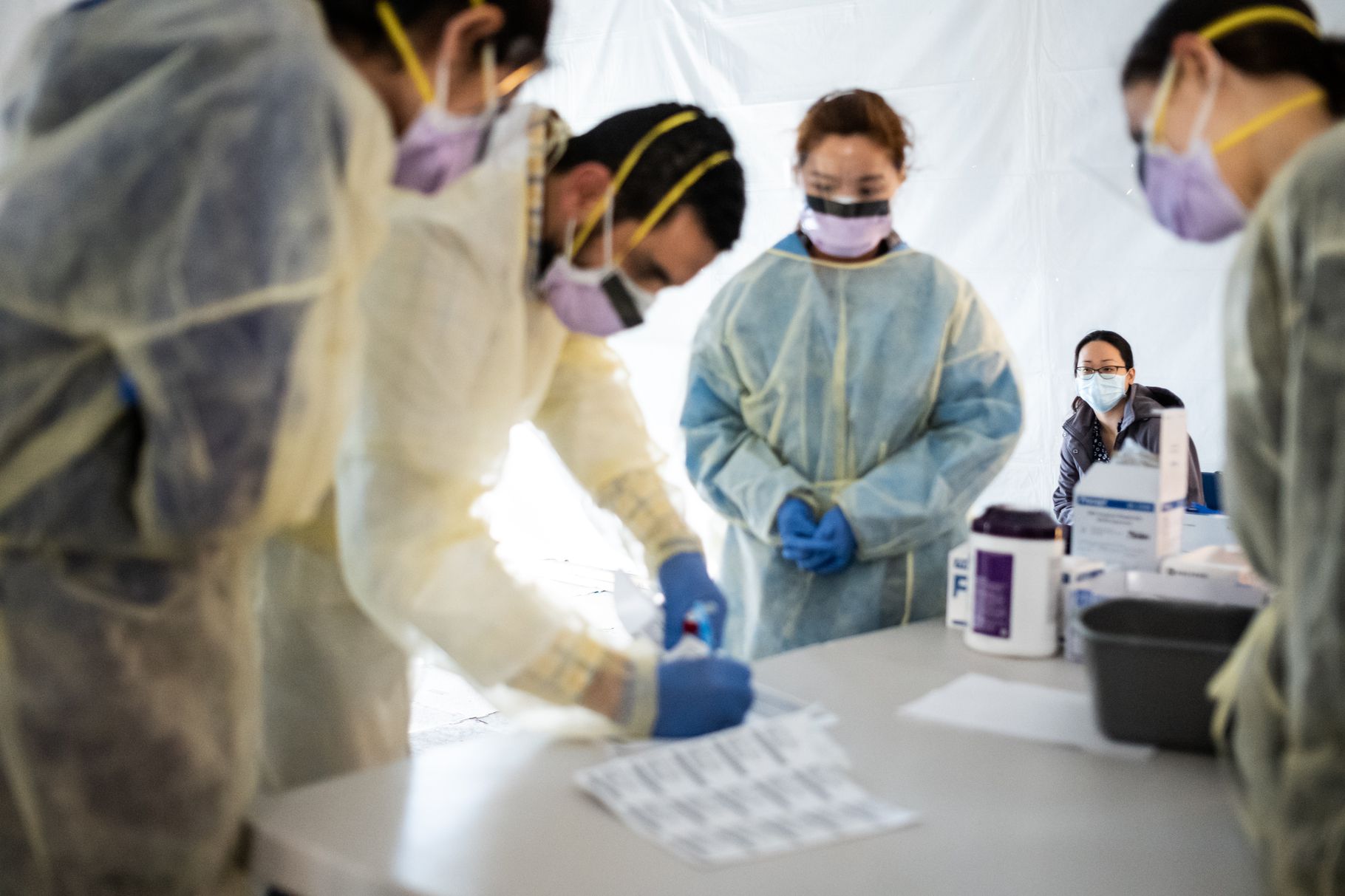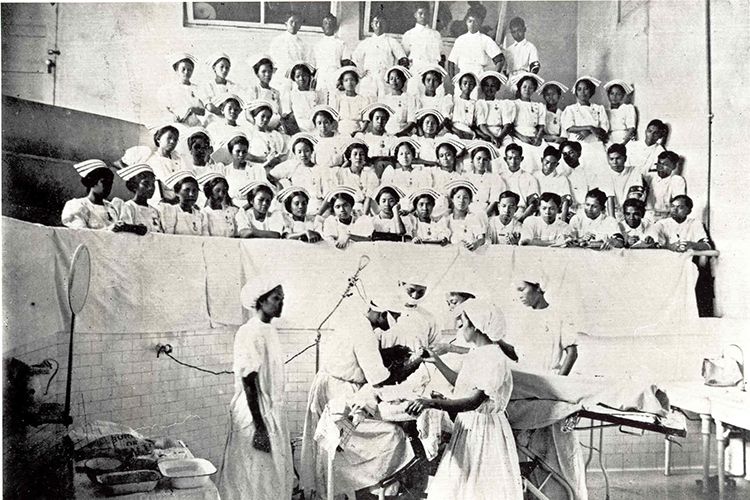In the era of COVID-19, time is illusory. I measure my days by my parents’ shifts. At 7:30pm, I hear the front door of our home open. My mother unloads the plastic bags in her purse carefully, hanging her stethoscope on the door handle. “I’m sanitizing,” she explains, wiping down each article with alcohol. As the next step of our ritual, she runs past me to wash her scrubs in the basement.
My mother’s immigration story follows a standard narrative: she lived in poverty in a rural part of the Philippines, and nursing was the only avenue of income available to her. Born into a family of sustenance farmers and the second eldest of seven, my mother fixed herself on school. My uncle eventually dropped out of college so that my mother could continue her studies and support the family as an overseas nurse. She went to Saudi Arabia, which still imports nursing labor today, then returned to the Philippines to have my sister. When she reapplied to return to Saudi Arabia, the nursing agency assigned her to a new site in New York instead.
None of our personal histories exist in a vacuum. My mother is one of the many Filipino nurses that immigrated to New York City in the late 1980s at the peak of the AIDS epidemic in the United States. These Filipino nurses, treated as a source of disposable labor, filled jobs that American-born nurses refused to take as they combatted an unknown, deadly virus. Now these same nurses, particularly susceptible because they are in their 60s and 70s, are on the frontlines for COVID-19 response.

Today, it is not an overstatement to say that Filipino healthcare workers are risking their lives as a powerful force in the COVID-19 pandemic, and that many Filipino-Americans share a common immigration story or know a Filipino nurse working abroad. The majority of Filipinos have family members and loved ones on the frontline. With this comes the Filipino community’s collective worry. Despite accounting for only 1% of the American population, Filipinos comprise more than 4% of practicing nurses in the United States.
The history of Filipino nurses in America is more than a century long, linked to imperial ties between the United States and the Philippines that began with the establishment of a nursing school in Manila by the American colonial government in 1907. The passage of the 1965 Immigration and Nationality Act led to the first large migration of Filipino nurses into the United States. The steady flow of Filipino nurses continued through the 1970s, further exacerbated by the Marcos administration’s implementation of martial law and subsequent Labor Export Policy that pushed Filipinos to find employment abroad. Nurses became key figures in the migration of Filipinos to America, as the United States had established the Philippine nursing model to replicate the United States healthcare system during its colonial regime.
From 1980 to 1990, the population of Filipinos in the United States nearly doubled in size from 774,652 to 1,406,770. Not coincidentally, the 1980s marked the beginning of the AIDS epidemic in America. Facing labor shortages, hospitals relied on foreign-born nurses to fill the deficit that American-born nurses had left when refusing to work during the epidemic. By March 1992, the New York City metropolitan area had become an epicenter of the AIDS crisis, reporting more than 35,000 AIDS cases to the Centers for Disease Control and Prevention that year.

At the forefront of that epicenter, Filipino nurses treated patients and organized for their own rights as workers. Eduardo Capulong, Esq., a former volunteer with the Filipina Nurses Organizing Project, described the group’s work with the Philippine Center for Immigrant Rights in the 1980s throughout its battle against aggressive recruiters that targeted Filipino women seeking work overseas. The recruiters, licensed by the Philippine Overseas Employment Agency, resorted to manipulative recruitment tactics, offering false promises to obtain green cards, pay for uniform and housing, and secure high salaries for the nurses. When the Filipino women arrived in America, the recruiters not only failed to deliver on these promises, but actively exploited them. Some recruiters took disproportionate fees from the nurses’ salaries and subjected the healthcare workers to inhumane living conditions. As many as eight Filipino migrant nurses would be packed into a studio and charged exorbitant rents and “living fees”. Some recruiters even confiscated the nurses’ passports. Such maltreatment and abuse, at the height of the movement, drove one young Filipino nurse to commit suicide (E. Capulong, personal communication, 2020).
The Filipina Nurses Organizing Project toiled on multiple fronts to achieve justice. Among their demands were better working and living conditions for Filipino migrant nurses, hospital-sponsored H1B visas, and salary parity with American-born hospital employees. Organizers worked with hospitals to alleviate overcrowding and reverse unconscionable recruitment fees. Simultaneously, the Filipina Nurses Organizing Project rallied to reclassify crooked recruiters, thereby removing their certification from the Philippine government. Outside of New York City and across the United States, Filipino migrant nurses similarly combated wage discrimination throughout the 1980s and 1990s, advocating for equal pay. In a notable 1999 case, Filipino nurses secured a $2.1 million settlement against a Missouri nursing home that paid its Filipino workers $6.00/hr less than its American-born employees.
In 2020, the material conditions in the Philippines created by Marcos’ remittance-dependent economy and fortified by his governmental successors still drive Filipinos abroad for work. The demand for Filipino nurses in western nations has increased in the thick of the COVID-19 pandemic. But Filipino nurses are not the only ones impacted by COVID-19; many overseas Filipinos are essential migrant workers that occupy labor-intensive jobs and provide reproductive care to families. The Philippine Overseas Employment Administration reported in 2017 that 1,992,746 workers were deployed as overseas Filipino workers internationally. This statistic is already an astronomical number, but it does not even include the ~1 million undocumented overseas Filipino workers living in the United States. Filipino migration to the United States continues to be funneled through the project of American citizenship as the promise of inclusion through citizenship forces Filipino workers from their homes and into dangerous situations at the cost of their livelihood.
Today, organizations like Migrante, Kabataan Alliance, and Anakbayan-NY continue the legacy of the Filipina Nurses Organizing Project by advocating for migrant workers and providing resources for relief and education in the Filipino-American community. As we care for our peers and tend to community, we remember that the lives and labor of Filipino people are not disposable.

Comments powered by Talkyard.